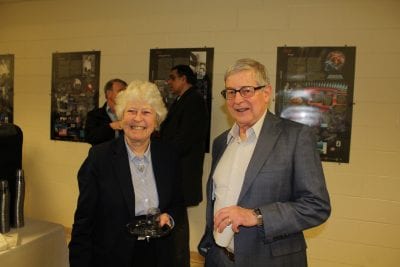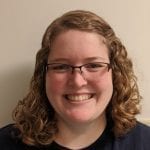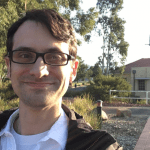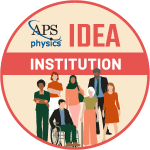Courtesy of RiverEast
 Loading...
Loading...
Courtesy of RiverEast
 Loading...
Loading...
When I arrived in Storrs from New York City in 1969 to teach physics at the University of Connecticut, one of the first colleagues I met was Dr. Cynthia Peterson. She had an infectious enthusiasm that appealed to me and my wife Anne. It turned out that Anne and Cynthia had both been students at Bryn Mawr College at the same time, another thing that bound us together. We remained colleagues and friends for decades until she finally retired in 2016, after nearly fifty years on the faculty. I felt she deserved a special retirement party on campus after all that time, and helped to facilitate it.
There are many memories: one is that she was the regular instructor in a large astronomy class year after year. This course continued from the time I came to Storrs into the present decade. Having an interest in astrophysics, I filled in for her to teach elementary astronomy for a year while she was on leave and I was mentored by her in preparation. This gave me an appreciation for the quality of her teaching and the effort she put into it.
Teaching for her was more than imparting facts: it included an introduction to research, how facts in science were discovered. An important part of the course was the hands-on observing sessions where students would use a telescope on the roof of the physics building to look at the moon, planets like Saturn, Mars and Jupiter, plus a number of distant galaxies. I had little experience in practical astronomy and Cynthia got me started on that. It is noteworthy that Cynthia and Jerry’s two children are named Celeste and Tycho.
I found out that outreach to the public and community was an important part of the astronomy course because of local interest. Cynthia conducted an extensive outreach program to the community, appearing on radio shows and sometimes on television. Working with her gave me an opportunity to devise some undergraduate research projects using the UConn roof-top telescopes. One project involved a survey of sunspots and observing the sunspot pattern moving which indicated that the sun is rotating slowly on its axis like the earth. Over the years, Cynthia helped many students; particularly female students, with similar research experiences.
One year, when Cynthia was up for promotion, we served together as co-advisors for a graduate student on a spectroscopy project involving experiments using an ultraviolet spectrometer the she had in her lab and a small ion accelerator in my laboratory. This project combined our expertise to provide a richer experience for the student. When our daughter Sarah reached high school, she worked one or two summers as an assistant to Cynthia on some research on dating pre-Columbian pottery samples through a study of the light they emit when heated to high temperature (thermoluminescent dating). The emitted light was due to damage to the material from cosmic rays over the years since the pottery was first fired. This mentoring gave Sarah an appreciation for science as well as a role-model for how to do it, that a father could not replace. Sarah later followed her mother and Cynthia to Bryn Mawr, graduating with honors; though not in science.
Not all our interactions were work related: we shared memberships in the Mansfield Family Recreation Association, which provided an affordable cooperative winter lodge in Northfield, Vermont (once the governor’s residence) in the heart of the ski country. Several families in Eastern Connecticut with teenage children were members that combined outdoor activity, winter and summer, with socializing in the evening. Cynthia and Jerry Peterson were particularly active in this: Cynthia served as Treasurer of the Association for many years.
The Physics Department at UConn had an annual hike up Mt. Monadnock (near Jaffrey, NH) during the height of the fall colors. We joined the Petersons for this event for several years, which featured a picnic on top and dinner on the way home.
In the last few years, with Cynthia and me both retired, UConn’s Physics Department has moved into more advanced astronomy, starting a graduate research program in that field and hiring several new faculty, initially including two women. Women in physics and astronomy faculty are still underrepresented. The program seems very popular with students, both undergraduate and graduate; its success has led to new funding and substantial research. At Cynthia’s retirement, I remarked in jest, but not entirely so, that it has taken three people to replace her.
She set the stage and provided a demonstration of student interest that helped justify the new program. She will be very much missed as a colleague and friend. She has left a strong legacy not only in the field of astronomy, but has been a particular inspiration for women in science more generally.

Winthrop Smith
Research Professor and Prof. Emeritus, Physics
University of Connecticut,
Storrs, CT. 06269-3046
Tel: (860)377-0941. Email: winthrop.smith@uconn.edu
Erin Scanlon joins our Department in fall 2020 as Assistant Professor in Residence at the Avery Point Campus. Erin comes to UConn with an impressive track record of university teaching experience and scholarship in physics education research (PER).
After earning a master’s degree in physics from Georgia Institute of Technology, Erin joined the faculty at Texas Lutheran University from 2012-2017 where she developed and taught introductory physics courses and the associated labs. In parallel to that, Erin pursued PhD in the developmental education doctoral program at the Texas State University, the only program of its kind in the nation, where she earned her PhD in 2017 receiving the 2018 Texas State University Outstanding Dissertation Award. Subsequently Erin accepted a position as a preeminent postdoctoral scholar at University of Central Florida in the group of Dr. Jackie Chini. Erin is a renowned expert in the field of physics education research. Her research, supported by intra- and extra-mural grants, was published in the top PER and STEM education journals. Recently Erin’s research focused on two main streams: investigating how studio physics is implemented across multiple institutions in the nation, and investigating how to support people with disabilities in STEM fields.
Erin is one of the founding steering committee members of the APS Inclusion, Diversity, and Equity Alliance (APS-IDEA) launched by APS in summer 2020. This new APS initiative is a world-wide alliance to support departments, national labs and other institutions to identify and enact strategies for improving equity, diversity and inclusion which is much needed in physics. APS-IDEA is a great success with currently more than 90 admitted teams including UConn, see the article on APS-IDEA (to avoid conflict of interest our application was not reviewed by Erin). Erin is also the vice chair of the Physics Education Research Leadership and Organizing Council (PERLOC) which is the leadership body for the physics education research community and founded the Conference Accessibility Working Group.
Erin is committed to outreach and initiated at the Texas Lutheran University highly successful outreach events, called Family Physics Night, which brought together members from the university and local community members. Once settled in, Erin is looking forward to start similar outreach and research activities. Erin moved to Connecticut with her husband Matt who is also a scholar in PER and teaches physics at post-secondary level. We are excited to welcome Erin as a physics faculty in our department, and look forward to working with her.

It’s been crazy.
That holds for everybody over these past six months; UConn and the Physics Department as well. Events unfurled rapidly last March. Within a week the March Meeting of the APS was cancelled, our department had to postpone the 2020 Katzenstein Lecture with Donna Strickland, and then the University announced that students would not return to campus after spring break, with classes moving online and research labs shut down. The work of the department is now ramping back up, though many courses will remain online through spring semester 2021.
The Physics Department has seen turnover in personnel. Three long time faculty members have left the department this summer: Phil Gould has retired, Robin Cote has moved on to be the Dean of Science at UMass Boston, and Susanne Yelin has taken a position at Harvard. All three will maintain ties with us for the foreseeable future. We have some new faces as well. Professors Daniel Angles-Alcazar and Chiara Mingarelli were hired in fall 2019 on bridge positions with the Center for Computational Astrophysics of the Simons Foundation. They both spent 2019-20 at CCA, coming to Storrs full time this fall. We have hired Professor Chris Faesi to complete our initial construction of an Astrophysics group, though he will delay his start at Storrs until fall 2021. We also have hired Professor Erin Scanlon to a position at the Avery Point campus, though during 2020-21 she will spend some time at teaching at Storrs. Another addition to our department is University President Thomas Katsouleas. He is a plasma physicist with academic appointments in Electrical Engineering and Physics. Apparently, his other duties keep him busy, but he has managed to attend a few department events and a faculty meeting.
Despite the pandemic, the department has had notable events and successes. I highlight a few here. We moved into our newly renovated building in August 2019. While there have been a host of construction hiccups, the building is now mostly completed. Our new research labs are state of the art, we have new teaching spaces that allow for moving to a new method of teaching introductory physics, and bright airy spaces throughout. In November we hosted Dame Jocelyn Bell Burnell for the 2019 Katzenstein Lecture. The event was a rousing success as we packed the student union theater and had record attendance at the banquet. We have had some great research success. The most prestigious awards given to new faculty members are the CAREER awards from federal agencies. We now have an unprecedented four active CAREER awardees: Professors Andrew Puckett, Daniel McCarron, Jonathan Trump, and most recently Luchang Jin. Congratulations to all four.
Looking forward, the immediate future remains daunting. We anticipate significant pandemic restrictions for another year and budgets for the university and research agencies are unsettled. Yet the department remain strong. We continue innovative work in education and research, we have an increasing number of excellent physics students, and dedicated faculty with a particularly strong young cohort. When the situation allows, please come visit us to see how we are evolving.
The transition to online learning that was necessitated due to the COVID-19 outbreak was not without its challenges. Faculty had roughly 10 days to adapt to a modality of instruction most were not used to. TAs had to simultaneously learn how to teach remotely while also adjusting to having the courses they were taking also be changed to a distance-based format. Instructors strived to provide reassurance to the more than 2,000 undergraduate students enrolled in physics courses that they would be able to complete their courses. Additionally, the department faced an important question: How would we be able to finish teaching the lab courses now that the campus was closed?
The remarkable efforts of faculty, graduate TAs, and our teaching staff proved to be instrumental in guaranteeing the successful completion of the spring semester. The faculty e-mail listserv was suddenly bursting with activity with instructors eager to share their experiences and help disseminate helpful information to their colleagues. This spirit of camaraderie was also shared by the graduate students, with several TAs stepping up and taking on additional workload to help peers that were facing additional challenges related to the difficult circumstances.
After Spring Break, classes resumed without additional disruptions – courses were being taught either synchronously with classes largely maintaining their original schedule, or through recorded lectures faculty would release on a regular schedule. Exam assessments were shifted to a distance-based format, with some of the larger introductory courses successfully implementing exams through their online homework platforms. The newly redesigned studio courses continued to be taught following a model that sought to promote student interactions and active learning, with several instructors continuing their use of clickers as a formative assessment tool in their distance-based courses. Collaborative problem-solving tutorial sessions continued to be administered as well, with TAs facilitating these activities through the use of breakout groups during the class sessions.
Even with all these strategies rapidly coalescing, we still the faced the unprecedented situation of having to teach lab courses in a distance-based format. Through the diligent efforts of several of our faculty, teaching staff, and graduate TAs, the department was able to resume lab courses without interruptions after Spring Break. This was done by providing students with the structure they needed to complete their coursework. Several creative (and in some cases innovative) solutions were implemented for lab instruction. Howard Winston, an Assistant Professor in Residence from our Waterbury campus, transformed his living room at home into a physics lab room, where he would perform the experiments live on camera for his students while getting their input on how to run the experiment. In a span of 10 days, James Jaconetta, Hannah Morrill, and Zac Transport, our lab technicians from the Storrs campus, remarkably recorded videos performing each of the experiments and demonstrations still remaining in our course schedules. They also supplemented this video library with a list of videos also curated from other reputable internet sources to help support several instructors teaching introductory courses in Storrs and some of the regional campuses.
The collective efforts of dozens of members of our department ultimately guaranteed the successful completion of the Spring 2020 semester even in unfavorable circumstances. While there were many challenges faced throughout the period, there was no shortage of positive feedback provided by students through formal (SETs) and informal means (conversations) demonstrating an appreciation for the organization and structure provided in their courses. During the summer months, instructors and teaching staff utilized their experiences and the feedback received in the spring to improve their strategies for distance-based learning. As an example, several lab courses in the fall are now running activities through a combination of simulations and “at home” experiments students are performing with household items, smartphones, and lab kits assembled by our teaching staff and sent to students.
Ultimately, necessity is the mother of invention, and there is optimism that some of the lessons learned now are helping drive teaching innovations that will still add value to our courses even when we resume in person instruction.
UConn Physic alum, Dr. Hyewon Pechkis, an Assistant Professor of Physics at the California State University Chico recently received the prestigious CAREER award from the National Science Foundation. This five-year grant titled “Making a Difference in First Year Underrepresented Students’ Education through Research: Quantum Coherence in a Bose Thermal Gas” will facilitate the involvement of CSU Chico undergraduates in experiments on ultracold atoms and quantum science. Hyewon was a graduate student with Prof. Ed Eyler, receiving her PhD from UConn in 2010 for her work on ultracold molecules. Congratulations Hyewon!
We are very excited to extend a warm welcome to a new UConn Physics Faculty member, Dr. Christopher Faesi. Chris is an astrophysicist, specializing in both observational work and modelling, primarily in the study of star formation. He got his PhD at Harvard University, followed by a postdoc at the Max Planck Institute for Astronomy in Heidelberg. Most recently Chris was awarded a prestigious NSF Postdoctoral Fellowship at UMass Amherst, and will be on research leave this academic year, completing this Fellowship. Chris is heavily involved in several large-scale international collaborations that will probe the physics of the interstellar medium in nearby galaxies with unprecedented resolution and spectral coverage. He also has extensive experience leading mentorship and outreach activities devoted to students at all levels, as well as the general public. We are looking forward to welcoming Chris to UConn!

Kyungseon Joo, a professor of physics, has been named Chair of the CLAS Collaboration, one of the largest international collaborations in nuclear physics. CLAS involves 50 institutions from 9 countries and has about 250 collaborators. The collaboration recently completed the upgrade of the CEBAF Large Acceptance Spectrometer (CLAS12) for operation at 11 GeV beam energy in Hall B at Jefferson National Laboratory in Newport News, VA, funded by the United States Department of Energy.
CLAS12 is based on a dual-magnet system with a superconducting torus magnet that provides a largely azimuthal field distribution that covers the forward polar angle range up to 35°, and a solenoid magnet and detector covering the polar angles from 35° to 125° with full azimuthal coverage. Trajectory reconstruction in the forward direction using drift chambers and in the central direction using a vertex tracker results in momentum resolutions of 1% and 3%, respectively. Cherenkov counters, time-of-flight scintillators, and electromagnetic calorimeters provide good particle identification. Fast triggering and high data-acquisition rates allow operation at a luminosity of 1035 cm−2s−1. These capabilities are being used in a broad scientific program to study the structure and interactions of nucleons, nuclei, and mesons, using polarized and unpolarized electron beams and targets for beam energies up to 11 GeV.
As Chair, Joo represents the collaboration in scientific, technical, and managerial concerns, while he closely works with the Lab management on scheduling experiments, organizing collaboration activities and expanding the reach of the collaboration. He currently focuses on collaboration-wide efforts to timely make first publications from CLAS12 with high impact science.

The Physics Department’s Diversity & Multiculturalism Committee (DMC) was accepted into the APS Inclusion, Diversity and Equity Alliance (APS-IDEA).
Despite years of efforts on local and national levels, the diversity in many physics departments is not reflective of the diversity nationwide. Our department is no exception in this regard. The new APS initiative was created to advance equity, diversity, and inclusion (EDI) in physics by establishing a community of transformation. The international network is formed of teams from over 90 physics departments, laboratories, and other organizations from USA, Canada, Brazil, Germany, and Finland that share the same EDI goals.
The inaugural virtual workshop took place this Summer with over 180 attendees, including APS, AIP, advisory board, and the APS-IDEA steering committee. The next workshop is scheduled for September and more workshops will be organized throughout the year. Acceptance of the departmental DMC positions the UConn Physics Department on the map of global institutions to collectively exchange ideas, learn, and enact strategies for improving EDI in physics. What can we expect? The vision of this initiative is to make physics community more inclusive. The participating teams will exchange ideas/experiences, deepen their knowledge of EDI research and effective practices, and receive guidance to prepare realistic sustainable plans for improving EDI.
Our APS-IDEA team consist of members at the Physics Department from all departmental levels (faculty, staff, graduate and undergraduate students). Current team members are: Elena Dormidontova (Chair of Diversity & Multiculturalism Committee), Gayanath Fernando, Gloria Fonseca Alvarez, Menka Jain, Aditi Mahabir, Belter Ordaz Mendoza (team contact), Dave Perry, Peter Schweitzer, Megan Sturm, Jonathan Trump, Diego Valente, and Susanne Yelin. The application was supported by the Department Head Barry Wells. All members of the Physics Department are invited and encouraged to join our APS-IDEA team. Together we can enhance inclusion and belonging in physics.
https://www.aps.org/publications/apsnews/202008/aps-idea.cfm
